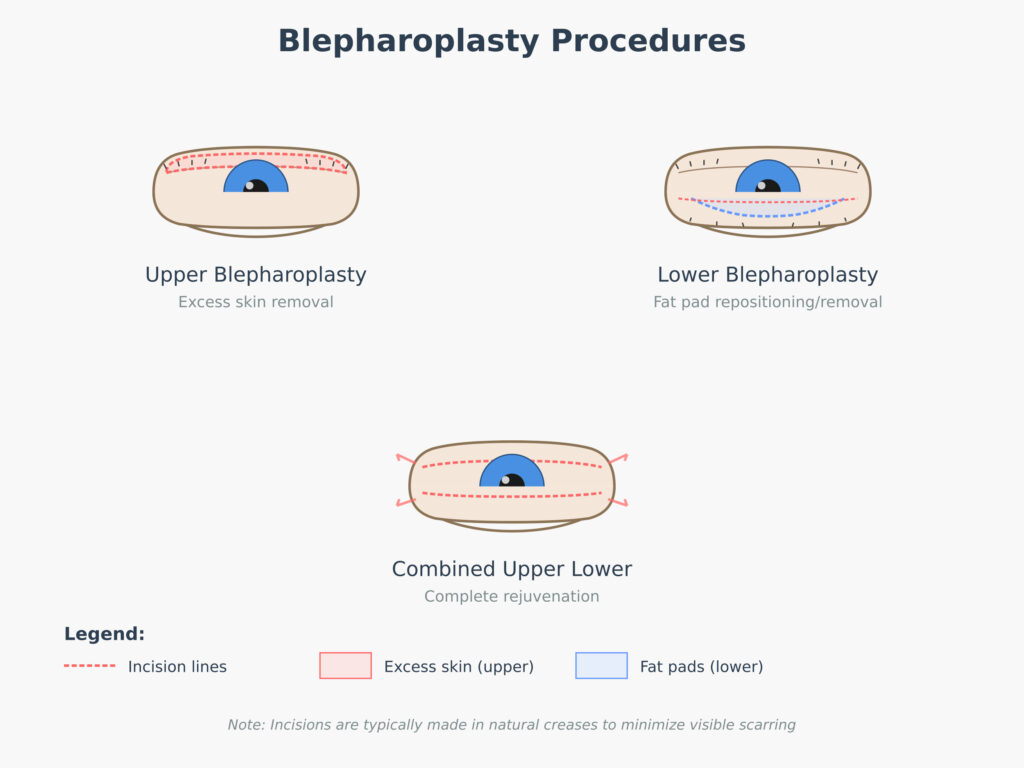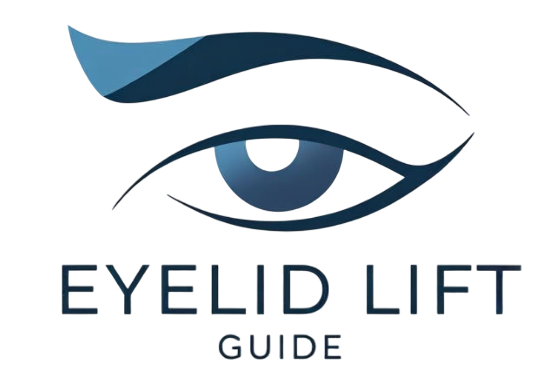Complete Guide to Eyelid Surgery: Upper & Lower Blepharoplasty Explained
A Patient’s Guide to Eyelid Surgery Procedures
If you feel that tired-looking eyes or drooping eyelids are making you look older than you feel, you are not alone. Eyelid surgery is one of the most transformative cosmetic surgeries performed today. This guide will explain the different eyelid surgery procedures (medically known as blepharoplasty) available to help you understand how you can achieve a more youthful, alert, and refreshed appearance with natural-looking results.

Understanding the Types of Eyelid Surgery Procedures
The first step in your journey is understanding which procedure best addresses your specific concerns. Generally, the options are divided into upper eyelid, lower eyelid, or a combination of both.
Upper Blepharoplasty (For Hooded or Droopy Eyelids)
Upper eyelid surgery is designed to correct «hooding,» where excess skin droops over the natural crease of the eyelid. In some cases, this skin can even hang over the eyelashes and impair peripheral vision. During this procedure, your surgeon makes a fine incision within the natural eyelid crease. Through this well-hidden incision, excess skin and small pockets of fat are removed. As a result, the eye looks more open, the eyelid platform is more defined, and the overall appearance is significantly more youthful and rested.
Lower Blepharoplasty (For Under-Eye Bags and Puffiness)
Lower eyelid surgery is the definitive solution for puffy «bags» and excess, wrinkled skin beneath the eyes. Your surgeon can use one of two primary approaches. Firstly, for patients whose main issue is protruding fat, an incision can be made on the inside of the lower eyelid, leaving no visible scar. Secondly, if both excess fat and loose skin need to be addressed, the surgeon will make a discreet incision just below the lower lash line. Ultimately, both techniques smooth the transition from the lower eyelid to the cheek, eliminating shadows and creating a refreshed contour.
Furthermore, many patients achieve the most harmonious and dramatic transformation by combining both upper and lower eyelid surgery procedures in a single session for a complete rejuvenation.
Your Journey: From Consultation to Final Results
Understanding the process from start to finish can help ease any anxieties and set clear expectations for your transformation.
The Consultation and Surgical Process
Your journey begins with a detailed consultation where your aesthetic goals are discussed. The surgery itself typically takes 1 to 3 hours and is usually performed as an outpatient procedure under local anesthesia with sedation. Your surgeon will carefully mark the incision lines and then proceed to remove or reposition tissue as planned, closing the incisions with very fine sutures to minimize scarring.
The Recovery Timeline
While recovery varies for everyone, a general timeline is as follows:
- Week 1: This is when swelling and bruising are at their peak. You will need to rest, use cold compresses, and your sutures will likely be removed towards the end of the week.
- Weeks 2-4: You will see a significant improvement as bruising fades. Most patients feel comfortable returning to work and social activities, using makeup to cover any remaining discoloration.
- Months 1-6: Your final, beautiful results become fully apparent as all subtle swelling resolves and the incision lines fade to become nearly invisible.
Important Considerations for Your Blepharoplasty
Making an informed decision involves understanding all aspects of the procedure, from cost to choosing the right surgeon.
Choosing a Qualified Surgeon
This is the most important decision you will make. Always ensure your surgeon is board-certified in plastic surgery and has extensive experience specifically with facial procedures. Ask to see their portfolio of before-and-after photos and make sure you feel comfortable with them and their team. For instance, you can verify a surgeon’s credentials through official bodies like the American Board of Plastic Surgery.
Non-Surgical Alternatives
For those with very mild concerns or who aren’t ready for surgery, options like Botox and dermal fillers can offer temporary improvement. However, it’s important to understand that these treatments cannot remove excess skin or fat pads. Therefore, for significant and long-lasting results, surgical eyelid surgery procedures remain the gold standard.
Frequently Asked Questions
Is eyelid surgery painful?
Discomfort during recovery is typically mild and easily managed with prescribed pain medication. Most patients describe the sensation as soreness rather than sharp pain.
Will my scars be visible?
No. A skilled plastic surgeon is an expert at placing incisions within the natural lines and creases of the skin. Once healed, these scars are exceptionally difficult to detect.
How long do the results last?
The results are very long-lasting. While the natural aging process continues, the fat and skin that are removed are gone permanently. The procedure can easily make you look 10-15 years younger, and you will always appear more rested than if you had not had the surgery.
Ready to See a Brighter You?
Ultimately, eyelid surgery can have a profound impact on both your appearance and your confidence. The key to a successful outcome lies in having realistic expectations and choosing a highly qualified surgeon. If you are ready to explore your options further, the next step is to schedule a consultation.
Explore our main Facial Surgery page for more information on how we can help you achieve your aesthetic goals.

Your point of view caught my eye and was very interesting. Thanks. I have a question for you. https://accounts.binance.com/da-DK/register?ref=V3MG69RO
Thanks for sharing. I read many of your blog posts, cool, your blog is very good.
Thank you for your sharing. I am worried that I lack creative ideas. It is your article that makes me full of hope. Thank you. But, I have a question, can you help me?